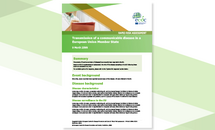Rapid risk assessment: Increase in OXA-244 -producing Escherichia coli in the European Union/European Economic Area and the UK since 2013, first update
Rapid risk/outbreaks assessment aim at supporting the countries and the European Commission in their preparedness and response to a public health threat. They provide a timely summary and risk assessment of a public health threat for EU/EEA countries related to a specific event. They also include potential options for response. As outbreaks or public health events develop, ECDC may issue updated risk assessments.
Executive summary
This update of a previous risk assessment on the same topic has been produced in response to the first evidence of healthcare-associated transmission of OXA-244-producing E. coli in the European Union/European Economic Area (EU/EEA), as well as a doubling of cases in the main cluster and three new countries having detected cases. These findings confirm the high risk for further spread of OXA-244-producing E. coli in the EU/EEA.
Following an urgent inquiry in ECDC’s EPIS AMR-HAI posted by Norway regarding a healthcare-associated outbreak involving 12 cases of OXA-244-producing Escherichia coli, national public health reference laboratories in EU/EEA countries were invited to submit to ECDC whole genome sequencing (WGS) data collected since the previous rapid risk assessment (18 February 2020) for an update at European-level. The analysis included WGS data submitted to ECDC from 13 countries, completed with data from the public domain. Among 458 isolates of E. coli ST38, 370 carried the blaOXA-244 gene encoding for the OXA-244 carbapenemase. Several clusters were identified, including one large cluster (cluster A) with 225 closely-related OXA-244-producing E. coli ST38 isolates. Of these, 210 isolates were detected in 11 EU/EEA countries and the UK, and 15 isolates were from other countries. The cluster has 20 cgMLST allelic differences from root to tip of the cluster subtree and isolates generally carried both the blaOXA-244 and blaCTX-M-27 genes. Cases related to cluster A had a median age of 51 years, a high proportion of women, and the isolates were frequently isolated from urine samples.
The source and route of transmission for OXA-244-producing E. coli in the EU/EEA and the UK is currently unclear, and there is a need for further investigation to determine this so that adequate control measures can be implemented. The wide geographical dispersion of cases within countries, without cases being linked in place and time, indicates transmission in the community as the main mode of spread. The epidemiological data are incomplete for many cases. However, from available data, the high proportion of isolates from urine samples (as compared to screening samples and other sample types) and a considerable proportion of outpatients at the time of sampling would also seem to indicate transmission in the community.
The low genetic diversity of isolates in cluster A could have several explanations, including a recently emerging clone, but may also point to a common source, place or region of acquisition for OXA-244-producing E. coli. Information on travel was available for only a few cases, limiting the validity of conclusions. Nevertheless, these scarce travel data point to North Africa and the Middle East as potential regions of origin for OXA-244-producing E. coli ST38, which is in line with the known distribution of OXA-48-like carbapenemases and previous environmental detection of OXA-244-producing E. coli ST38. However, it is unclear whether travel alone could sufficiently explain the widespread and rapid increase in cases in 12 different EU/EEA countries and the UK. Another possibility could be that a source product, potentially originating from the above-mentioned regions, has been distributed to the European countries involved or that there is transmission in the community within the EU/EEA and the UK.
Transmission via food (from animal or non-animal origin), by contact with the environment or direct contact with animals, is hypothetically possible. However, no OXA-244-producing E. coli isolates from food or animal sources have so far been identified in the EU/EEA. Imported food or animal products from regions where OXA-48-like carbapenemases are endemic, or even food from domestic sources can therefore neither be excluded, nor confirmed as a possible contributing factor. However, given the potential public health implications, the possibility of food and animal products contaminated with OXA-244 producing E. coli being distributed over a large geographical area requires investigation. Therefore, further studies need to be considered to determine the likelihood of the environment, crops, animals, and foods contaminated with OXA-244-producing E. coli having contributed to this outbreak.
The observed increase in the number of cases of a difficult-to-detect carbapenemase (OXA-244) in a species (E. coli) that causes community-acquired infections is of concern. Data are missing on the clinical consequences of carbapenems being used for treatment of OXA-244-producing E. coli infections. However, other OXA-48-like carbapenemases have been associated with treatment failures despite in vitro susceptibility. The risk for further spread of OXA-244-producing E. coli in the EU/EEA is high, given the rapid and simultaneous increase in various EU/EEA countries. A recent healthcare-associated outbreak in Norway has shown that OXA-244-producing E. coli ST38 has the potential to spread in healthcare settings. The difficulties with laboratory detection related to the relatively low level of carbapenem resistance conferred by the OXA-244 carbapenemase are probably resulting in considerable under-detection. Without adaptation of microbiological methods and surveillance, OXA-244-producing E. coli may therefore continue to spread unnoticed.
If awareness, sampling frequency and capacity to detect OXA-244-producing E. coli is improved in clinical microbiology laboratories, and appropriate infection prevention and control measures are implemented on a timely basis, the risk for transmission within healthcare settings can be reduced. Options for achieving such a reduction include national alerts to clinical microbiology laboratories, laboratory guidance to improve detection of OXA-244-producing E. coli and submission of all suspected isolates to national reference laboratories for further analysis. This should be combined with the collection of epidemiological data on cases and associated risk factors including travel and healthcare history, nutritional habits and contact with animals. A questionnaire has been developed by ECDC for further investigation of cases and can be made available upon request. Prevention measures for OXA-244-producing E. coli in healthcare settings should be implemented as recommended for other carbapenem-resistant Enterobacterales. For further details, please refer to the ‘Options for response’ section below.
Download

Read more on ECDC website
Antimicrobial resistance - Escherichia coli
Escherichia coli resistance to major antibiotics is increasing in almost all countries in Europe. E. coli causes urinary tract and more serious infections and is one of the most common bacteria causing infections.
Facts about Escherichia coli
Escherichia coli (E.coli) are very common bacteria in the gastrointestinal tract, and part of the normal bacterial flora.







